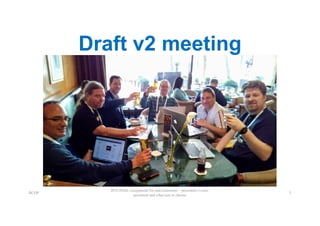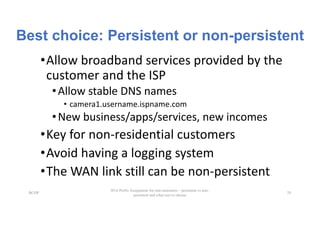Best Current Operational Practice for Operators IPv6 prefix Assignment for end-customers
- 1. Best Current Operational Practice for operators: IPv6 Prefix Assignment for end- customers - persistent vs non- persistent and what size to choose Jordi Palet jordi.palet@consulintel.es BCOP IPv6 Prefix Assignment for end-customers – persistent vs non- persistent and what size to choose 1
- 2. Authors: • Andrew Alston • Gert Doering • Jan Žorž • Jen Linkova • Jordi Palet • Kevin Meynell • Lee Howard • Luis Balbinot • Mark Townsley • Primož Dražumerič • Sander Steffann BCOP IPv6 Prefix Assignment for end-customers – persistent vs non- persistent and what size to choose 2
- 3. Draft v2 meeting BCOP IPv6 Prefix Assignment for end-customers – persistent vs non- persistent and what size to choose 3
- 4. RIPE BCOP TF • Work in Progress: • https://www.sinog.si/docs/draft-IPv6pd-BCOP-v7.pdf • https://www.ripe.net/ripe/mail/archives/bcop/2017-August/000173.html BCOP IPv6 Prefix Assignment for end-customers – persistent vs non- persistent and what size to choose 4
- 5. Table of Content 1. Executive Summary 2. What is a BCOP? 3. Introduction and incentives 4. Size of end-customer prefix assignment: /48, /56 or something else? 4.1. Numbering the WAN link (interconnection between our network and the end-customer CPE): 4.1.1. /64 prefix out of a dedicated pool of IPv6 prefixes 4.1.2. Unnumbered 4.1.3. ULA 4.1.4. /64 prefix out of the IPv6 prefix assigned to the end-customer 4.1.5. Summary 4.2. Prefix assignment options 4.2.1. /48 for everybody 4.2.2. /48 for business customers and /56 for residential customers 4.2.3. Less than /56 4.2.4. Considerations for cellular operators 5. End-customer IPv6 prefix assignment: Persistent vs non-persistent 5.1. Why non-persistent assignments may be perceived as “easier” than static ones 5.2. Why non-persistent assignments are considered harmful. 5.3. Why persistent prefix assignments are recommended 6. Acknowledgements 7. Glossary of terms and acronyms BCOP IPv6 Prefix Assignment for end-customers – persistent vs non- persistent and what size to choose 5
- 6. Executive Summary • Making wrong choices when designing your IPv6 network will sooner or later have negative implications … • IPv6 is not the same as IPv4. In IPv6 you assign a short prefix to each end- customer site, so they are able to have as many subnets (/64s) as they need. • It is strongly discouraged to assign prefixes longer than /56. If you want a simple addressing plan, /48 for each end-customer. • In order to facilitate troubleshooting and have a future proof network, you should consider numbering the WAN links using GUAs. • Non-persistent prefixes are considered harmful in IPv6 as you can’t avoid issues that may be caused by simple end-customer power outages, so assigning persistent prefixes is a safer and simpler approach. BCOP IPv6 Prefix Assignment for end-customers – persistent vs non- persistent and what size to choose 6
- 7. BCOP and Why? •Describe best actual practices •Target: ISPs deploying IPv6 •Lack of experience or following IPv4 practices bring unexpected or unwanted results • IPv6 “brokenness” = Content providers rejection of your AS • Lack of compliance with new standards such as Homenet • Complete production network renumbering, etc. BCOP IPv6 Prefix Assignment for end-customers – persistent vs non- persistent and what size to choose 7
- 8. Size of end-customer prefix •/48, /56 or something else? •Change your mind, this is not IPv4! •IPv6 has been designed to assign prefixes not addresses •Tony Hain “maths”: • IPv6 lifetime over 480 years, and keep doing that several times • Scarcity of addresses is not going to be our next problem BCOP IPv6 Prefix Assignment for end-customers – persistent vs non- persistent and what size to choose 8
- 9. /64 ? •DO NOT DO THAT! BCOP IPv6 Prefix Assignment for end-customers – persistent vs non- persistent and what size to choose 9
- 10. /64 ? •DO NOT DO THAT! •NEVER! BCOP IPv6 Prefix Assignment for end-customers – persistent vs non- persistent and what size to choose 10
- 11. /64 ? •DO NOT DO THAT! •NEVER! •NO WAY! BCOP IPv6 Prefix Assignment for end-customers – persistent vs non- persistent and what size to choose 11
- 12. /64 ? •DO NOT DO THAT! •NEVER! •NO WAY! •BROKEN! BCOP IPv6 Prefix Assignment for end-customers – persistent vs non- persistent and what size to choose 12
- 13. /64 ? •DO NOT DO THAT! •NEVER! •NO WAY! •BROKEN! •VERY BAD FOR YOU BCOP IPv6 Prefix Assignment for end-customers – persistent vs non- persistent and what size to choose 13
- 14. /64 ? •DO NOT DO THAT! •NEVER! •NO WAY! •BROKEN! •VERY BAD FOR YOU •BAD FOR YOUR CUSTOMER BCOP IPv6 Prefix Assignment for end-customers – persistent vs non- persistent and what size to choose 14
- 15. Numbering the WAN link 1./64 out of the end-customer prefix 2./64 out of a dedicated pool 3.Unnumbered 4.ULA BCOP IPv6 Prefix Assignment for end-customers – persistent vs non- persistent and what size to choose 15
- 16. /64 from customer prefix •Use the 1st /64 from the customer prefix • https://tools.ietf.org/html/draft-palet-v6ops-point2point • Simplifies routing and provisioning •Some CPEs may not support RFC6603 • Prefix exclude option for DHCPv6-PD •Even being required by RFC7084 • Basic Requirements for IPv6 CPEs BCOP IPv6 Prefix Assignment for end-customers – persistent vs non- persistent and what size to choose 16
- 17. /64 from dedicated pool • Most common scenario • Dedicated pool for WAN links • CPE performs router discovery • If it is a host (PPPoE), setup is completed • If it is a router, will request a prefix (DHCPv6-PD) • /126, /127, /112 or /64? • RFC6164 suggest /127 • Not all hardware supports it • /64 is future proof • Hardware limitations for longer than /64 prefixes • Allocate /64, use /127 to prevent ND attacks • If there is *always* a CPE, you can apply security policies w/o harming customers BCOP IPv6 Prefix Assignment for end-customers – persistent vs non- persistent and what size to choose 17
- 18. Unnumbered • Don’t use GUAs • Instead use Link-Local • Doesn’t work for all the devices, which can’t request DHCPv6-PD • No GUAs means no traffic … • Complicate troubleshooting • Not able to traceroute the point of failure • Not suitable for unknown CPEs or non-CPEs attached to the WAN link • End-host will stay unnumbered • Some hardware may consume additional resources for numbered links BCOP IPv6 Prefix Assignment for end-customers – persistent vs non- persistent and what size to choose 18
- 19. ULA •Strongly discouraged •ICMPv6 from the CPE to outside ISP •ULA source address will not traverse filters •PMTUD will break •IPv6 connection will break if Path MTU is not the same BCOP IPv6 Prefix Assignment for end-customers – persistent vs non- persistent and what size to choose 19
- 20. WAN link summary •/64 GUA is the recommended choice • From the customer prefix if RFC6603 is supported •It may be even required when more that 2 endpoints • Managed bridges • Repeaters • Redundancy (VRRP, multiple routers) • Monitoring/troubleshooting devices BCOP IPv6 Prefix Assignment for end-customers – persistent vs non- persistent and what size to choose 20
- 21. Prefix assignment options •Align the size of the delegated prefix with a nibble boundary (multiples of 4 bits), so it match DNS reverse zone delegations •A single customer network is /64 • A single /64 is plain wrong • IETF work allows a single /64 for an interface •Multiple /64 must be the rule • RIR policies allow /48 BCOP IPv6 Prefix Assignment for end-customers – persistent vs non- persistent and what size to choose 21
- 22. /48 for business, /56 residential • Some operators do this • Rationale -> Marketing/Sales differentiation • Advanced home users may have problems with this • You’re not able to use all the 4 digits (/48-/56) • Some may have already an addressing plan with /48 (ULA, TB, transition, etc.) • /56 forces to redo it + renumbering • /48 just means changing the prefix • Alternatively, reserve /48, assign /56 • Are you considering SMEs? BCOP IPv6 Prefix Assignment for end-customers – persistent vs non- persistent and what size to choose 22
- 23. /48 for everybody •Most practical and pragmatic •Less call-centre time to sort out problems •Single “flat” provisioning system •Same prefix size as ULAs, transition, etc. •Direct mapping of existing addressing plans BCOP IPv6 Prefix Assignment for end-customers – persistent vs non- persistent and what size to choose 23
- 24. Less than /56 •Not recommended • Technically no reason for that, enough addresses, this is not IPv4! • Over 134 million /56 in a /29 • Over 16 million /56 in a /32 •Ask for more space to your RIR if required •Never assign a single /64 • Except for cellular phones (1 /64 for each PDP) •LTE modems still require /56 or /48 BCOP IPv6 Prefix Assignment for end-customers – persistent vs non- persistent and what size to choose 24
- 25. Persistent or non-persistent •Persistent typically by means of AAA or custom provisioning system • At customer connection they always get the same prefix •Non-persistent by means of a big pool in each termination point • At customer connection they get a random prefix • If persistent, the lease time may provide days, weeks or even months BCOP IPv6 Prefix Assignment for end-customers – persistent vs non- persistent and what size to choose 25
- 26. Non-persistent is easier? •Less effort to deploy • Issues come later • It comes from IPv4 practices, DHCP • But we have NAT! • Looks easier for aggregation • Not looking for “customer” portability • May be an extra service •Commonly using DHCPv6-PD • Each end-customer device has a GUA BCOP IPv6 Prefix Assignment for end-customers – persistent vs non- persistent and what size to choose 26
- 27. However … non-persistent is harmful • In case of power failure, CPE hang-up, … • Common even in highly-developed countries • CPE doesn’t send prefix valid lifetime = 0 • End-customer devices keep the old prefix • Will try to use it, will fail • Customers claims to the call-centre • Content providers measure IPv6 brokenness • Will ignore your IPv6 traffic • Power outage often happen several consecutive times … • Non-persistent prefixes force a logging system BCOP IPv6 Prefix Assignment for end-customers – persistent vs non- persistent and what size to choose 27
- 28. Best choice: Persistent or non-persistent •Allow broadband services provided by the customer and the ISP •Allow stable DNS names • camera1.username.ispname.com •New business/apps/services, new incomes •Key for non-residential customers •Avoid having a logging system •The WAN link still can be non-persistent BCOP IPv6 Prefix Assignment for end-customers – persistent vs non- persistent and what size to choose 28
- 29. Questions? Thanks! BCOP IPv6 Prefix Assignment for end-customers – persistent vs non- persistent and what size to choose 29





























